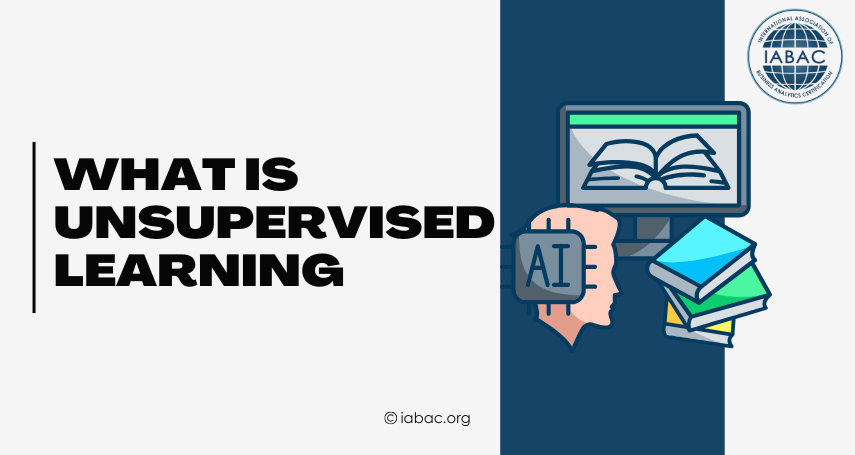What is Unsupervised Learning? | IABAC
 seenivasan V
seenivasan V
Computers can now recognize patterns in data and make wise decisions thanks to machine learning, which is transforming a number of industries. Unsupervised learning is an essential field of machine learning that enables models to uncover hidden structures and patterns in data without the need for human-labeled samples. The idea of unsupervised learning, its uses, advantages, and distinctions from supervised learning will all be covered in this guide.
What Do You Mean by Unsupervised Learning?
In unsupervised learning, an algorithm evaluates data without the use of specific labels or predetermined results. Without knowing the results beforehand, unsupervised learning looks for patterns, structures, and correlations in raw data, in contrast to supervised learning, which uses labeled examples to teach a model.
In unsupervised learning, algorithms try to find anomalies, group or cluster data points according to commonalities, or lower dimensionality in order to gain more insightful information. Numerous domains, including fraud detection, recommendation systems, and customer segmentation, make extensive use of it.
Key Characteristics of Unsupervised Learning
No Labeled Data: No categories or labels have been applied to the training data.
Pattern Discovery: The algorithm finds groups, relationships, or structures in the dataset.
Exploratory Analysis: This technique is frequently used to explore data and provide insights.
Self-Organizing Models: These models classify or arrange data independently, without the need for human assistance.
How Does Unsupervised Learning Work?
Analyzing the basic structure of data is how unsupervised learning systems operate. These algorithms aim to uncover undetected relationships within a dataset or group related data elements. Typically, the procedure includes:
Input Data Collection: The collection of raw, unlabeled data.
Feature extraction: The process of locating important data characteristics.
Clustering or Pattern Identification: The approach uses similarities to group data points.
Optimization and Evaluation: Improving outcomes and guaranteeing significant insights.
Common Types of Unsupervised Learning
It can be divided into two main categories:
1. Clustering
Clustering algorithms group similar data points together. It is commonly used for customer segmentation, document categorization, and anomaly detection.
Popular Clustering Algorithms:
K-Means Clustering: Creates 'K' clusters from the data.
Hierarchical clustering: It creates a network of nested clusters that resembles a tree.
Density-Based Spatial Clustering (DBSCAN): Identifies noise and clusters of any shape.
2. Dimensionality Reduction
The goal of dimensionality reduction approaches is to make high-dimensional data simpler while keeping important information intact. This helps to speed up computations and visualize complicated datasets.
Popular Dimensionality Reduction Techniques:
Principal Component Analysis (PCA): Converts variables into principal components, thereby reducing the dimensionality of data.
t-Distributed Stochastic Neighbor Embedding (t-SNE): Visualizes high-dimensional data in two or three dimensions.
Autoencoders: A neural network-based technique that preserves data correlations while lowering dimensions.
What is an Example of Unsupervised Learning Data?
Unsupervised learning is used in many different fields to assist academics and businesses in find hidden patterns. The following are some real-world instances of unsupervised learning data:
1. Customer Segmentation
Clustering algorithms are used by marketing and e-commerce businesses to divide up their customers according to browsing history, demographics, and purchase behavior. This helps companies in customizing marketing plans and recommendations.
2. Fraud Detection
Banks and financial institutions leverage anomaly detection techniques to identify suspicious transactions. By detecting outliers, unsupervised learning helps prevent fraudulent activities.
3. Medical Diagnosis
In healthcare, clustering and dimensionality reduction techniques help analyze medical images, detect diseases, and classify patients based on genetic or clinical data.
4. Recommendation Systems
Streaming services such as Netflix and Spotify employ unsupervised learning to identify user preferences and recommend material in the absence of explicit user ratings.
5. Social Network Analysis
Unsupervised learning is used by social media companies to find groups, spot fake accounts, and examine user behavior to show relevant ads.
Advantages of Unsupervised Learning
Works with Unlabeled Data: Effort and time are saved by eliminating the requirement for manual data labeling.
Discovers Hidden Patterns: Draws insightful conclusions from unprocessed data.
Improves Decision-Making: Assists researchers and companies in making data-driven choices.
Scalability: The ability to effectively handle big datasets.
Improves Data visualization: It makes complicated data easier to understand.
Challenges of Unsupervised Learning
Lack of Accuracy: It is challenging to verify results because there are no labels.
Complexity of Interpretation: It can be difficult to figure out why a model grouped data in a specific way.
Computationally intensive: Processing big datasets requires a lot of resources from some algorithms.
Sensitive to Parameters: Depending on the starting point and parameter adjustment, results may differ.
Differences Between Supervised and Unsupervised Learning
Feature | Supervised Learning | Unsupervised Learning |
Data Type | Labeled data | Unlabeled data |
Goal | Predict outcomes | Discover hidden patterns |
Example Algorithms | Decision Trees, SVM, Neural Networks | K-Means, PCA, Autoencoders |
Application | Spam detection, stock prediction | Customer segmentation, fraud detection |
Future of Unsupervised Learning
Unsupervised learning will continue to be important across a range of businesses as big data grows. Developments in self-supervised learning, deep learning, and reinforcement learning are expanding the potential of unsupervised techniques, increasing their accuracy and efficiency.
Emerging Trends
Self-Supervised Learning: A combination of unsupervised and supervised methods of learning.
Deep clustering: The process of improving clustering performance by using deep learning models.
Anomaly Detection Driven by AI: Using advanced anomaly detection methods to improve cybersecurity and avoid fraud.
Unsupervised learning is a potent machine learning technique that uses unlabeled examples to reveal hidden patterns in data. It has numerous and expanding uses, ranging from medical diagnostics to customer segmentation. Even with these obstacles, unsupervised learning will become more effective and significant in the future as deep learning and artificial intelligence continue to progress.
Data scientists, business analysts, and AI practitioners must have a solid understanding of unsupervised learning. In many businesses, becoming proficient in unsupervised learning will lead to new opportunities for efficiency and creativity as data-driven decision-making becomes increasingly important.
Subscribe to my newsletter
Read articles from seenivasan V directly inside your inbox. Subscribe to the newsletter, and don't miss out.
Written by
